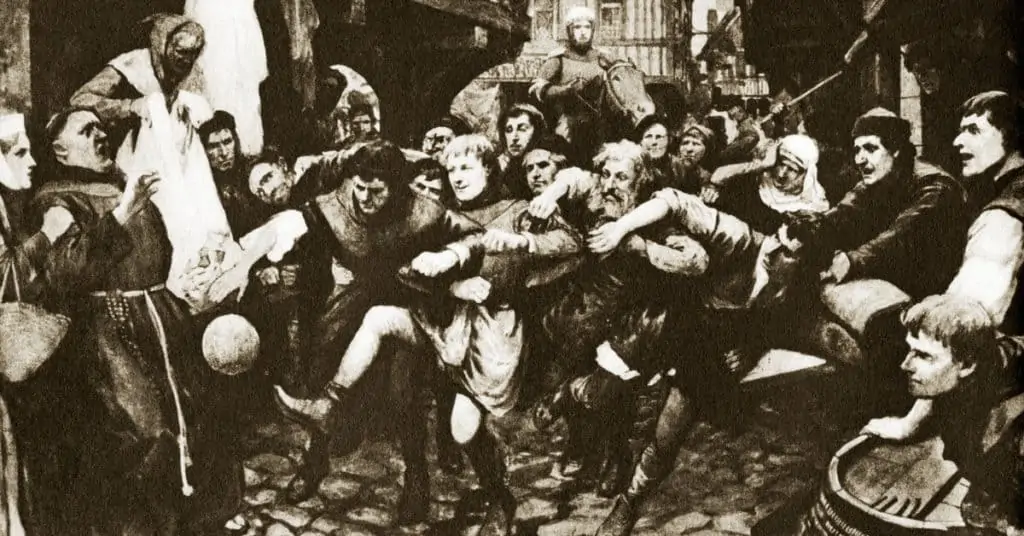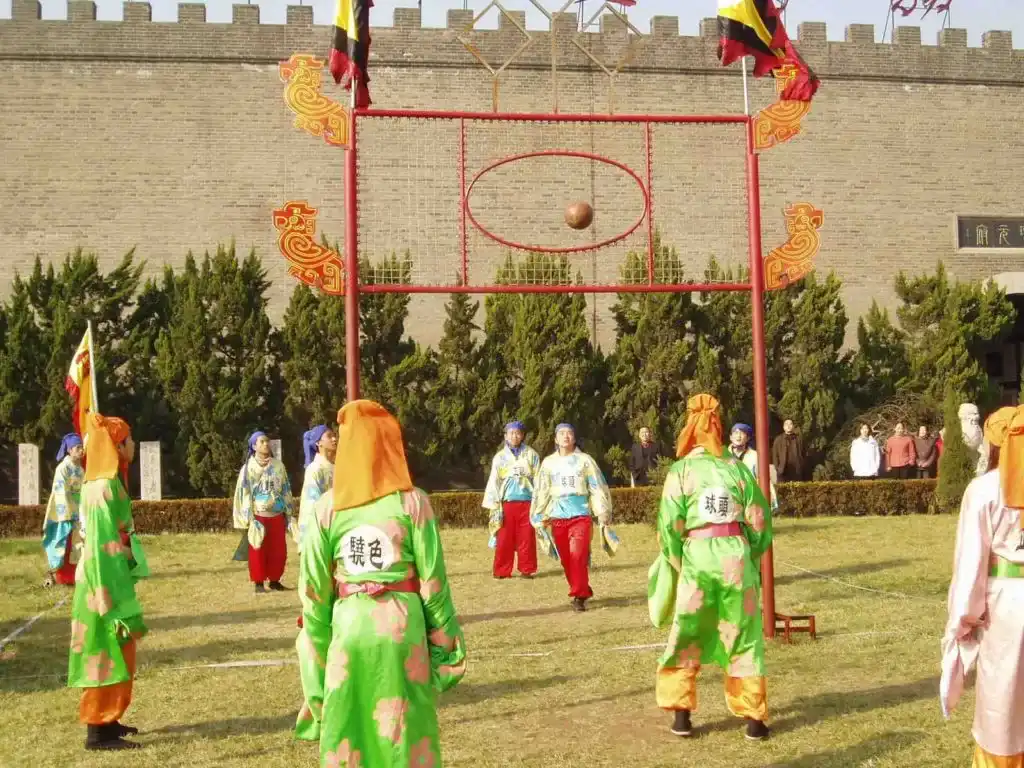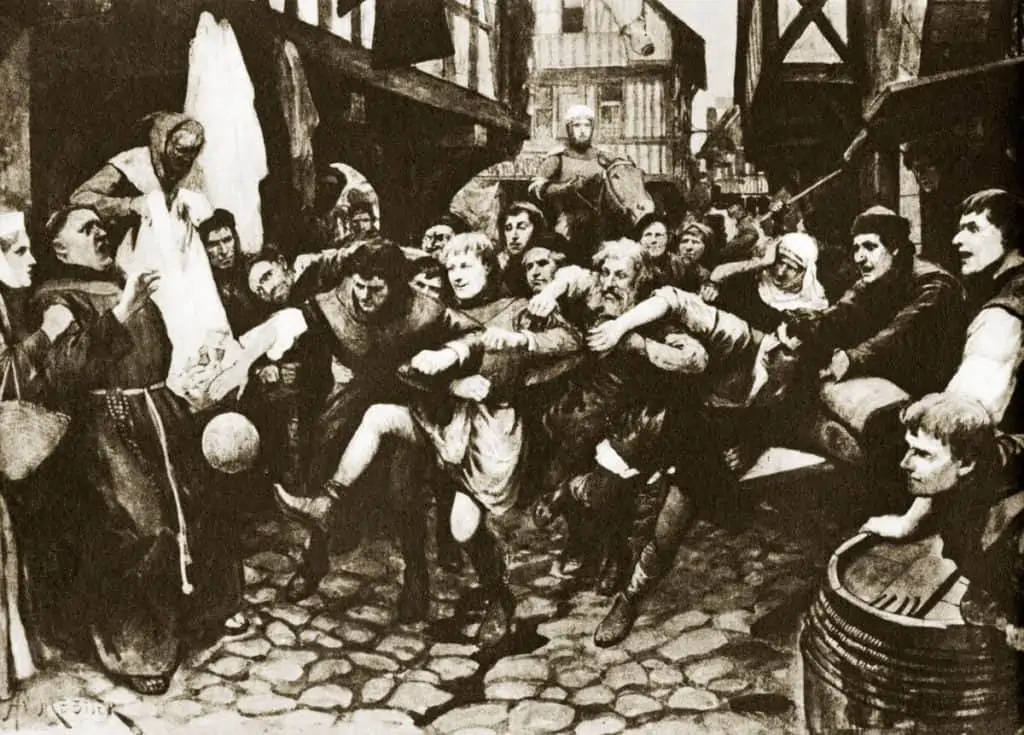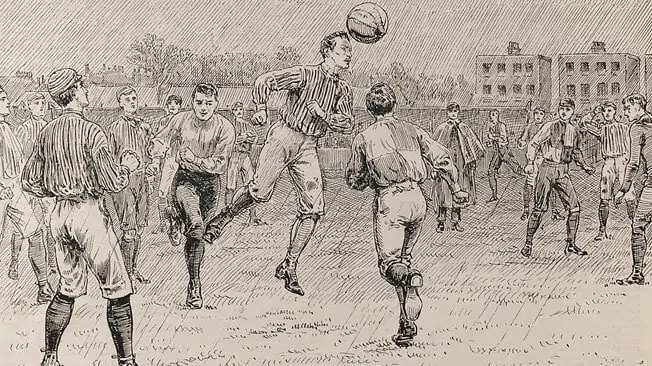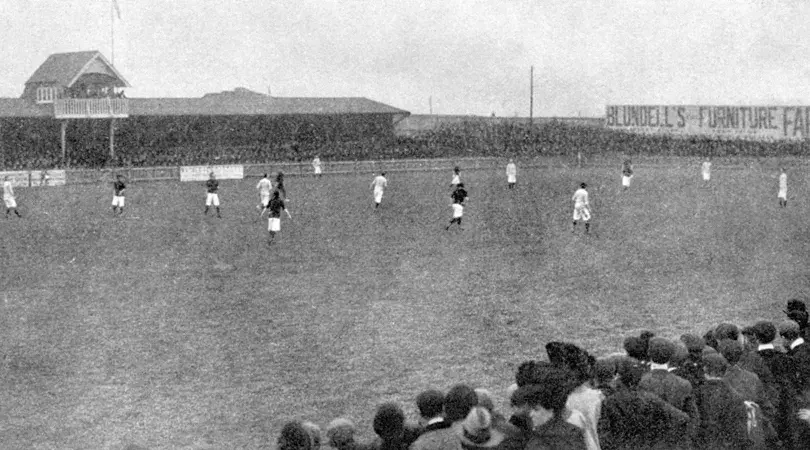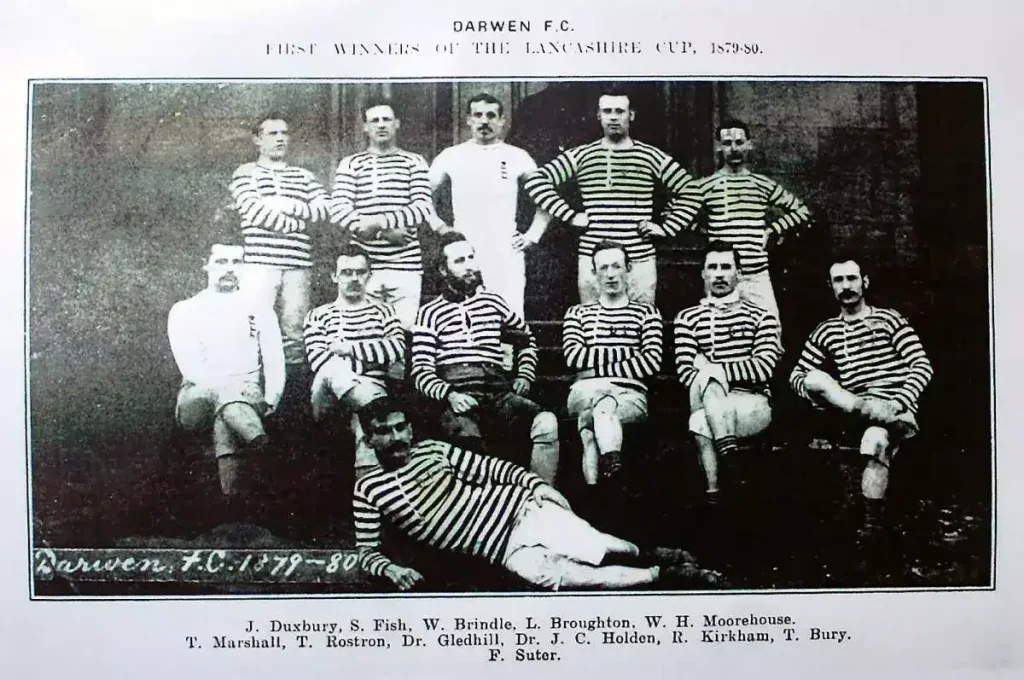The invention of English football dates back more than a century. In 1863, rugby football split into two distinct courses in England. The Football Association became the world’s first football association. Both forms of English football have a common origin and a long and intricately branched family tree. At least a half-dozen games existed in their early history, varying in different ways. The historical development of the invention of English football is related and has been traced back 2000 years.
In some cases, this can be disputed. However, playing with the feet has existed for thousands of years, and there is no reason to think it is an aberration of the more “natural” play with hands. Furthermore, many different games were played in their early history in varying degrees, from which football evolved and is related.
Where Was Football Invented
Scientific evidence dates back to the 2nd and 3rd centuries B.C. when football techniques were exhibited in China. Among the physical education exercises found in a Han Dynasty military manual is “Tsu Chu.”
The feat consisted of kicking a leather ball filled with feathers and hair into a net attached to a bamboo cane through a narrow opening, which demanded superior skill. There was also a variation of this exercise. To counter his opponents’ attacks, the player had to use his feet, chest, back, and shoulders to aim at his target. Hands were not allowed.
In the Far East, there was also a variation of today’s game called Japanese Kemari. That game can be traced back to the 5th to 6th centuries. It’s essentially a type of circular football game, it’s much less spectacular, but that makes it more dignified and ceremonious.
It requires some skill, but it’s not competitive, or even close to it, in the way Chinese games were. The players had to pass the ball in a relatively small space without touching the ground, like hacky sack.
Greek And Roman Games
There is relatively little record of the Greek game Episkyros, but the Roman game Harpastum was more exciting. Each team played on a rectangular field marked by boundary lines and a centerline with a smaller ball. The aim was for the ball to pass over the opponents’ lines.
It was a game filled with trickery and passing the ball between players.
Team members were assigned specific tactical assignments, and spectators followed the proceedings with intense interest. Feet played such a minimal role in this game that their significance was negligible. Thus, even though it was introduced to England by the Romans, the game may not have been the forerunner of modern football.
The same holds for hurling, another popular Celtic game played in Cornwall and Ireland. Again, there is a possibility that influences were asserted, but the decisive development of the game of football in which we are present today occurred in England and Scotland.
Early UK Football
In the British Isles, football flourished from the 8th to the 19th centuries and had a variety of local and regional forms that were subsequently streamlined and modernized to become the present-day games of association football and rugby football.
Compared to all previously known forms, they were much more disorganized, violent, spontaneous, and an indefinite number of players usually played them. There were often heated contests among whole villages or townships – across streets, village squares, fields, hedges, fences, and streams.
Almost anything was allowed, including kicking.
However, due to the weight and size of the ball used in some of these games, kicking was impossible. Instead, opponents were fallen by kicking. Standard ball size and weight were not established until nine years after the football rules were set up for the first time in 1863.
Usually, the teams involved reached an agreement on this point when they arranged the match, as was the case when London and Sheffield played in 1866. A one-and-a-half-hour duration was set for the game for the first time in its history.
According to an ancient handbook, any method, aside from murder or manslaughter, could be utilized to get the ball to its target during Shrovetide football. Some areas still play Shrovetide football today on Shrove Tuesday, for example, Ashbourne in Derbyshire.
However, it is evident that it is no longer as riotous as it once was, nor are there the same number of casualties as centuries ago.
Origins In England
The origins of football are reputed to be Anglo-Saxon, and its first appearance is the subject of many legends. According to legend, in the cities of Chester and Kingston-on-Thames, football was first played using the severed head of a vanquished Danish prince.
However, a victory celebration following a battle against the Romans is believed to have given rise to Derbyshire much earlier, in the 3rd century.
The Anglo-Saxon theory appears to conflict with specific facts, despite Kingston and Chester’s legends. The fact that it is not mentioned in early Anglo-Saxon literature or Saxon areas nor on the continent shows that it was not played at this time. It was only a Celtic ball game that was known before the Norman Conquest.
Did France Invent Football?
In the early centuries of this century, people in France, particularly in Normandy and Brittany, were playing a very similar game to the aforementioned “mob football” (also referred to as Folk Football) in the British Isles. As such, it is entirely plausible that the Normans brought this form of the game to England.
These theories produce a picture that is quite bewildering in its complexity – an image that is far more complex than the simple rules that govern this kind of game if they could even be called rules.
At the end of the 17th century, a game was played between married and unmarried women in the Scottish town of Inveresk, which, perhaps by design, was consistently won by the married women. Therefore, women’s football isn’t as new as some people think.
Although scholars disagree about who invented English football and the influences that certain cults may have had on its development, one thing is sure: association football has flourished in England and the British Isles for over a thousand years.
As a result of the string of prohibitions and censures, both harsh and mild, there was an immense amount of enthusiasm for football, despite it being so often frowned upon by the authorities. Moreover, despite their condemnation and threats of severe punishment, the country’s leaders and high offices failed to stop it repeatedly.
Banning Football In The UK
A proclamation was issued by the Lord Mayor of London in 1314 forbidding football in London due to the uproar it usually caused. Anyone breaking this law would be imprisoned. Football was regarded as a nuisance by King Edward III in 1331, who passed harsh regulations to suppress it. The French government also took similar measures.
England and France were at war for 100 years between 1338 and 1453, and the court was also opposed to association football, though for different reasons.
Henry IV, Edward III, Richard II, and Henry V made football illegal because the popular pastime prevented their subjects from practicing more useful military disciplines, the most important of which was archery in the English army.
Calcio
In Elizabethan times, football was especially popular. Probably one of the most critical influences in intensifying the native popularity for the game came from Renaissance Italy, which created their brand of football known as Calcio. It was, undoubtedly, more organized than the English version.
For example, during the gala events in Florence held during particular holidays, teams dressed in colored livery played the game.
As always, the game in England was rough, ungracious, and lacking in refinement. Yet, it was also supported by a leading figure who was moved by the players’ simple joy as they chased the ball. Richard Mulcaster, who headed the prestigious schools of Merchant Taylor’s and St. Paul’s, was one of football’s supporters.
Adding to its positive educational value and health benefits, he pointed out that the game promoted strength. However, a little refinement and a better manner were all that was needed, according to him. Among his ideas was to limit the number of participants in each team and, more importantly, to have a stricter referee.
There had been a lot of practical reasons for the resentment of association football until this point. Public disturbances resulting in property damage had been regarded as the cause of the game. For example, in 1608, Manchester was again banned from football due to smashed windows.
16th Century Football
In the 16th century, football was attacked in a new way. After the spread of Puritanism, amusements such as sport, mainly football, were classified as frivolous amusements. Thus, according to the complaint, it violated the Sabbath.
Theatres were similarly attacked by Puritans, who saw them as places of idleness and iniquity. As a result, entertainment was prohibited on Sundays during the Commonwealth and Puritanical eras that followed (even though Oliver Cromwell was a football enthusiast in his youth).
After that, Sunday football became taboo. Despite this, the ban remained in place for some 300 years before finally being lifted unofficially and then formally with the consent of the Football Association.
Despite all these obstacles, football could not be eradicated. A good example is Derby. Football was banned from the streets of the town beginning in 1731 and continuing until 1841. The only way to stop the game was to resort to riot laws.
For almost five hundred years, association football hardly progressed. Despite persistent bans for 500 years, the game was never totally eradicated. This resulted in it remaining essentially rough, violent, and disorganized.
The first significant change occurred in the 19th century, when school football became the norm, particularly in prestigious public schools. It was a pivotal moment. Innovations and refinements to the game were possible in this new environment.
19th Century Football
Due to the lack of a standard, organized football format, each school developed its adaptation, which differed significantly. Football’s traditional aspects were retained, but the playing surface determined innovations.
Mob football was not allowed because there wasn’t enough space. Several schools, such as Charterhouse, Westminster, Eton, and Harrow, invented a football game that depended more on dribbling virtuosity than vitality.
Schools such as Cheltenham and Rugby, on the other hand, prefer the wilder games in which the ball can be touched or carried with the hands.
Influence Of Public Schools On Football
When educators realized football wasn’t simply a romp for kids but could be educationally beneficial, these early styles were significantly boosted. In addition, it was acknowledged that it provided a valuable distraction from less desirable behaviors, such as heavy drinking and gambling.
In public schools, a “games cult” eventually developed around football. It became evident when the team game encouraged loyalty, selflessness, cooperation, subordination, and deference to the team spirit.
Football became a compulsory part of the school curriculum, as games became an integral part of the curriculum. The head of Rugby School, Dr. Thomas Arnold, went a step further by laying down Rugby rules in 1846, the first standardized rules for a game.
Even so, they were pretty rough. For example, kicking an opponent’s legs below the knees was permitted, but he could not be held still while his shins were worked on. Players could also handle the ball.
Rugby vs. Football
Rugby’s rules were adopted by many schools. Harrow, Winchester, and Eton rejected this form of association football and instead encouraged kicking the ball. Carrying the ball was also prohibited. Westminster and Charterhouse also opposed handling the ball. They did not isolate their style of play as some schools did but instead formed a nucleus from which it began to spread.
After former pupils at Cambridge University had tried in 1848 to find a common denominator between all the different versions of the game, a new initiative began in 1863 to establish some uniform standards and rules that everyone could agree on.
The majority of those present spoke out against rough customs such as tripping, shin-kicking, etc., and carrying the ball. This prompted the Rugby representation to threaten withdrawal. However, they were adamant about carrying the ball despite their agreement not to kick their shins, which was later banned by Rugby regulations.
This meeting in Cambridge aimed to clear up the utter confusion surrounding the rules. Finally, after several conferences organized in London at the end of the same year, a decisive step was taken.
English Football Association
The Freemason’s Tavern hosted eleven London football clubs and schools on 26 October 1863. They intended to clear up the confusion by establishing fundamental rules governing all of the matches played among the parties. Thus, the Football Association was born at this meeting.
Shin-kicking, tripping, and carrying the ball were the subjects of intense discussion at this and subsequent meetings until the die-hards gave up on the Rugby style. It was unlikely that they would win anyway.
They were not interested in playing a game that prohibited tripping, shin-kicking, and carrying the ball. The ideals had no longer been compatible. Finally, the game of football and rugby split in 1863. Six years later, the separation became irreconcilable when a provision was incorporated into the football rules that prohibited any ball handling (not only carrying the ball).
The Football Association had 50 member football clubs just eight years after its founding. This was the year of the first-ever football competition, the F.A. Cup, 17 years before the League Championship.
Great Britain staged international matches before European football was even heard of. English and Scottish players met for the first time in 1872. In the wake of this sudden boom of organized modern football accompanied by staggering numbers of spectators, specific problems were introduced with which other countries had not previously dealt.
Professionalism In Football
One of them was professionalism. It all started in 1879, when Darwen FC, a small Lancashire club, twice drew with the supposedly invincible Old Etonians in the F.A. Cup before they lost at the third attempt.
Darwin players John Love and Fergus Suter are reported to be the first to receive remuneration for their association football talents. Nonetheless, this practice increased, and the Football Association was compelled to legalize professionalism by 1885.
The following three oldest Football Associations are the Scottish F.A. (1873), the F.A. of Wales (1875), and the Irish FA (1880). At the first international match, England had no other partner association to face. The Scottish F.A. did not even exist when Scotland and England played in Glasgow on 30 November 1872 – it wasn’t founded until three months later.
In that match, England faced the oldest Scottish club team, Queen’s Park.

Modern Football Outside Great Britain
Because of the influence of the British abroad, modern football spread slowly outside of Great Britain but soon gathered momentum and spread rapidly throughout the world.
Following the Netherlands and Denmark in 1889, New Zealand (1891), Argentina (1893), Chile (1895), Switzerland, Belgium (1895), Italy (1898), Germany, Uruguay (both in 1900), Hungary (1901), and Finland (1907) formed their football associations.
France, Belgium, Denmark, the Netherlands, Spain (represented by Real Madrid FC), Sweden, and Switzerland formed FIFA in May 1904 in Paris. The German Football Federation also announced its intention to join the same day.
Despite occasional obstacles and setbacks, this international football community grew steadily. Fédération Internationale de Football Association (FIFA) was affiliated with 21 national associations in 1912. In 1925, there were 36 national associations. During the first World Cup, which was held in 1930, it was 41.
The number of countries reached 51 in 1938, and by 1950, after the Second World War, 73 countries were included. FIFA currently has 209 members worldwide as of 2022.
Conclusion
Today, football is played by millions of people worldwide and is considered one of the most popular and beloved sports in the world. Unfortunately, due to a lack of records, it is almost impossible to reconcile who invented football.
The modern version of the game, however, has its roots in England, where it was developed in the 19th century, and the Football Association established the first set of rules for the game in 1863.
